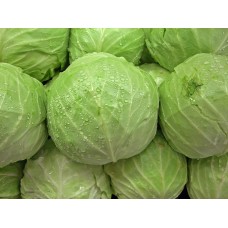Choose fresh, compact, firm, medium-size head heavy for its size.
Pests are common in cabbage. Conventionally grown heads may be
subjected to insecticide sprays to avoid pest infestation. Therefore, wash
thoroughly in cold running water, then soak in saline water for about 30
minutes. Then again give a gentle wash in clean water in order to remove dust,
pests, eggs/ova/cysts and any residual insecticides.
Cabbage is an excellent source of vitamin K, vitamin C and fiber, containing more than 20% of the Daily Value (DV) for each of these nutrients per serving.
Cabbage
is also a good source (10-19% DV) of vitamin
B6 and folate, with no other
nutrients having significant content per 100 g serving.
·
Fresh,
dark green-leafy cabbage is incredibly nutritious; but very low in fat and
calories. 100 g of leaves provide just 25 calories.
·
The
vegetable is a storehouse of phyto-chemicals like thiocyanates,
indole-3-carbinol, lutein, zea-xanthin, sulforaphane, and
isothiocyanates. These compounds are powerful antioxidants and known to
help protect against breast, colon, and prostate cancers and help
reduce LDL or "bad cholesterol" levels in the blood.
·
Fresh
cabbage is an excellent source of natural antioxidant, vitamin C. Provides
36.6 mg or about 61% of RDA per 100 g. Regular consumption of foods rich in
vitamin C helps the body develop resistance against infectious agents and
scavenge harmful, pro-inflammatory free radicals.
·
Total
antioxidant strength measured in terms of oxygen radical absorbance capacity
(ORAC value) is 508 µmol TE/100 g. Red cabbages contain more antioxidant value,
2252 µmol TE/100 g.
·
It
is also rich in essential vitamins such as pantothenic acid (vitamin B-5),
pyridoxine (vitamin B-6) and thiamin (vitamin B-1). These vitamins are
essential in the sense that our body requires them from external sources to
replenish.
·
It
also contains a adequate amount of minerals like potassium, manganese, iron,
and magnesium. Potassium is an important component of cell and body fluids that
helps controlling heart rate and blood pressure. Manganese is used by the body
as a co-factor for the antioxidant enzyme, superoxide dismutase. Iron
is required for the red blood cell formation.
·
Cabbage
is a very good source of vitamin K, provides about 63% of RDA levels.
Vitamin-K has the potential role in bone metabolism by promoting osteotrophic
activity in them. So enough vitamin K in the diet gives you healthy bones.
·
In addition, vitamin-K also has established
role in curing Alzheimer's disease patients by limiting neuronal damage inside
their brain.
Keeping
cabbage cold will keep it fresh and help it retain its vitamin C content. Put
the whole head in a plastic bag in the crisper of your refrigerator.
If you need to
store a partial head of cabbage, cover it tightly with plastic wrap and
refrigerate. Since the vitamin C content of cabbage starts to quickly degrade
once it has been cut, you should use the remainder within a couple of days.
Spicy cabbage with cumin,
Pickled cabbage,
Cabbage vadas
Cabbage
- Product Code: 160209
- Availability: In Stock
-
Rs.0.00
- Ex Tax: Rs.0.00



